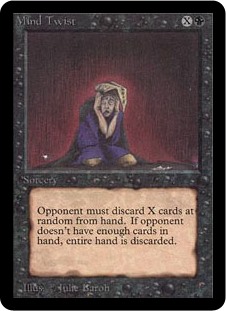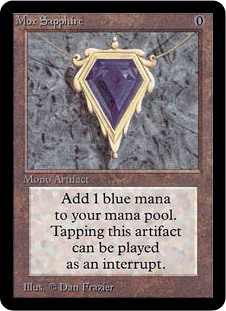Old School MTG is a varied format. There is not a single set of deck construction rules. Instead, we have many different groups of players that use different sets of banned and restricted cards. Every one of these groups has reasons for why they've chosen a slightly different path for individual cards. So, let's take a look at some of the fundamental reasons why we have banned and restricted cards in our game.
A quick note before we dive into this. The concepts we're covering apply to the entire game of Magic. We have years and years worth of game development to draw on that we didn't have back in the day when we were figuring this stuff out. "Old School" MTG variations sometimes include more sets or target sets up to a certain year. In other words, you could argue that Tempest Block Constructed is Old School MTG, but that's not usually how we use that label.
The Banned and Restricted list can be broken into a few sections. These sections help to define why a card is on the list. At a fundamental level, these cards are on the list because they make the game unfun. There are many ways to get to a definition of "unfun," but that's the heart of the problem with certain cards and why we've chosen to put them on the list.
 Ante
Ante
Take for example "ante" cards. They are on the list simply because we do not play with ante. The game was originally designed with ante, but players did not like the possibility of losing a rare or valuable card. So, ante cards are banned (and so is the ante rule).
It's important to keep in mind that the original game included the concept of ante. It was part of the design. In a way, ante balances the risk/reward relationship between including powerful cards in your deck. In a perfect world, where there is no cheating, there was a type of equity that a player would consider before including a card in a deck they were building. There existed a real possibility of losing that card permanently. We removed that equity when we removed ante; and in doing so, we removed the risk of card loss built into the original design.
I'm not saying that ante was good design. I'm saying that regardless of if we liked it or not as players, it was one of the balancing elements of the design to which we no longer have access.
 Game Design
Game Design
We have a few relevant concepts that have become better defined over the years of Magic design. One such example is "play patterns." Another example is "counterplay." These are concepts that are used more frequently now in recent banned and restricted announcements as explanations for cards that are added or removed from the list. Let's take a look at how they apply to our Old School format(s).
Play Patterns
A play pattern is simply how the game plays out given a certain set of inputs. This comes up many times in competitive play especially when the metagame has been solved and a set of "best" decks emerges. Players will talk about win percentages against a certain deck, for example. When you have two reasonably skilled players playing against each other with two solved metagame decks, the play patterns will be eerily consistent from game to game.
This isn't inherently bad. In fact, it is inevitable. As we are playing Old School with a fixed set of cards, the play patterns will become more ingrained over time. Known patterns of play will make certain match-ups more predictable than ever before. When you sit down with deck X against an opponent playing deck Y, the win/loss percentages will fall into a predictable range.
One objective of a banned and restricted list could be to include cards that increase the variance of viable deck archetypes. This creates more varied play patterns as there are more decks in the format and therefore more matches in the format. Ultimately though, with a fixed cards pool, all play patterns will become known.
 Counterplay
Counterplay
The concept of counterplay is simply how much one play pattern can be responded to (or interacted with) by another play pattern. Cards that reduce interactivity reduce counterplay. Prison-style decks are an example of a strategy designed to ultimately reduce interactivity to the point that counterplay is impossible. There's nothing wrong with this strategy, but only if there is an
opportunity for counterplay along the way.
To put this differently, if there is no opportunity for counterplay, there is no game. Cards and combinations of cards that result in a sufficiently low opportunity for counterplay are candidates for the banned and restricted list. One objective of a banned and restricted list could be to include cards that decrease the opportunity for counterplay.
 Unfun
Unfun
This is what I mean by cards being on the banned and restricted list because they are "unfun." Players don't like ante, so ante cards are banned. This has nothing to do with the individual ante cards and everything to do with the game mechanic of ante. In other words, the entire concept of ante is so "unfun" for enough players, that we do not play with that mechanic or any cards using that mechanic at all.
A format that consists of one or two best decks creates a limited set of play patterns. This is also "unfun," so cards are banned and restricted to increase the deck construction variance in an effort to increase the match variance and therefore to increase varied patterns of play.
Similarly, a format that consists of decks that create limited or no opportunity for counterplay is also "unfun." Games in a format like that are decided on a die roll. The player that goes first has an overwhelming advantage. Cards are added to the banned and restricted list to reduce the speed and consistency of decks with limited opportunity for counterplay.
 Nostalgia
Nostalgia
We have a glaring problem in Old School. The problem is that many of the cards on the restricted list are so degenerate that they should also be banned. But, we love those cards. They are iconic. With the exception of corner cases, Black Lotus makes every deck better. Why? Because it is off-the-charts broken. It always was.
The game only inherently had two ways to deal with the problem of broken cards. The card pool was limited. When the game was designed, it was entirely possible that your small play group would not have ever seen a Black Lotus. And if your small play group did happen to open a Black Lotus, it would have been one very strong card in a small pool of cards. Not one very strong card supported by the availability of every card ever printed.
The second way the game has to inherently deal with broken cards is the ante rule. If your Black Lotus was potentially up for grabs every game, you would have to weigh that possibility against the power of including the card in your deck. Without the ante rule, there is no reason to not include every Black Lotus you own in your deck unless we ban or restrict it.
Fast forward to today and we have neither of these inherent protections. Instead we have recognized that Black Lotus is too strong and have chosen to restrict it. Here's the interesting part. Black Lotus is still very, very broken, even though it is restricted; more so now that we have access to every card in the pool and years of understanding play patterns. Why isn't Black Lotus banned? Nostalgia. If we ban Black Lotus, does it still feel like we are playing Old School MTG? Probably not.
Because of Nostalgia, we are caught in a trap. Cards that are clearly broken are restricted from four copies per deck to one copy per deck when those cards should really be banned to both increase the deck variety (and therefore the play pattern variance) and to increase the opportunity for counterplay.
A Note About Swedish Rules
For better or worse, the Swedish Old School MTG rules have an extra layer of restriction that is not present in the other commonly adopted rule sets. In Swedish rules, the "reprint" rule is more much restrictive; notably, cards that are not printed in English and cards reprinted after Unlimited are not allowed. In other words, these significant restrictions place severe financial limitations on deck construction.
We can argue whether this approach to card legality is fair or elitist or any of the other words that have been thrown around, but looking at it from the point of cards they have chosen to be banned or restricted can help see why variations exist in these lists.
For example, if players are restricted to using only Alpha/Beta/Unlimited dual lands, the financial cost for a multi-colored mana base goes up considerably. It is more common in formats where Revised dual lands are allowed to see manabases that have access to every combination of colors the deckbuilder would want. It is more common under the Swedish rules to see non-optimal manabases, or to see deckbuilders gravitate to decks with less colors. This is a byproduct of a restriction not on the deck construction portion of Swedish rules, but rather on the card legality portion of the rules.
(In)Consistency
What we end up with is a fundamental lack of consistency in why cards are on the banned and restricted list. The complicating factor is Nostalgia. Cards that we know are a problem based on problematic play patterns are sometimes restricted when they should be banned. Other cards are banned because enough players simply do not like the play pattern. But many of us play Old School to relive the days when we played with these cards when they were new and we were still discovering the game. Many of the restricted cards are the cards we all chased after, in part because they were so powerful! Does banning these cards really make for better games? Maybe if those cards had never existed.
Why Are Cards Banned and Restricted in Old School MTG:
Part 1
Why Are Cards Banned and Restricted in Old School MTG:
Part 2
Why Are Cards Banned and Restricted in Old School MTG:
Part 3
Why Are Cards Banned and Restricted in Old School MTG:
Part 4




